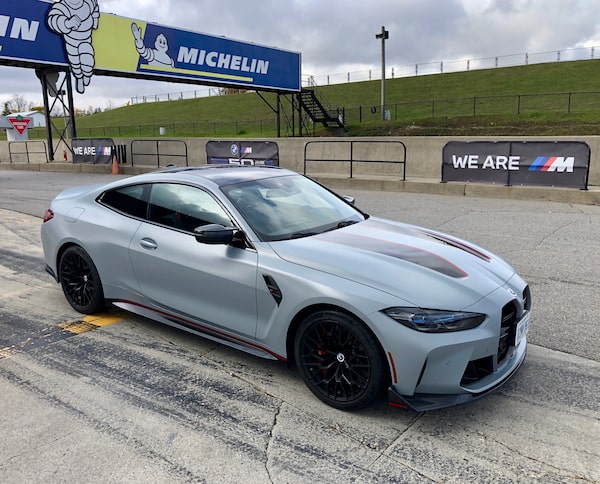
The BMW M4 CSL on the track at Canadian Tire Motorsport Park in Bowmanville, Ont., in October, 2022, as part of a BMW track day to celebrate the 50th anniversary of its M high-performance brand.Jeremy Sinek/The Globe and Mail
BMW decided to add some twists to its recent track day at Canadian Tire Motorsport Park in Bowmanville, Ont., just east of Toronto.
First, there was the requirement to drag race a high-performance sports coupe (the M850i) against an almost-three-ton electric SUV (the iX M60).
The race was effectively a wash.
Then we were sent through a tight and twisty slalom course in a selection of M-badged cars, including the iX M60. Yes, the electric SUV got it done. No, it wasn’t the fastest.
Finally, there was the surprising suggestion that I remove my helmet to drive the new M4 CSL, the fastest car of the day. More to come about that, but first, let’s step back and set the scene.
This track day was BMW Canada’s celebration of the 50th anniversary of its M high-performance brand. It was an assignment I could relate to. My hobby car is a 1995 M3. Moreover, the event brought to mind another long-ago assignment that’s still a career highlight: performance-testing the awesome M1 in 1980.
Even the slowest M car at the track this day – an M340i – is quicker than that mid-engined two-seat supercar in 1980: acceleration to 100 kilometres an hour in 4.4 seconds versus 5.9. The modern sedan would probably top the M1′s 259-kilometre-an-hour top speed, too, if it didn’t have an electronic speed limiter.

The BMW iX M60 prepares to race a BMW M850i. It was a virtual tie.Jeremy Sinek/The Globe and Mail
The M340i was one of nine models BMW brought to demonstrate the breadth and depth of its M performance brand. Besides the M340i and M850i, an M240i and the iX M60 represented what you might call the “M Lite” level.
Full-on Ms included the X3 M, the M3 sedan and the M4 coupe, all in their respective Competition versions (503 horsepower versus the base 473).
And then there was the limited-edition halo car, the M4 CSL, of which only 1,000 will be produced worldwide to mark M’s 50th birthday. Canada gets 42 of them, and they’re all spoken for.
The CSL makes 543 horsepower, 40 more than the M4 Competition, and weighs 108 kilograms less. That trims its sprint to 100 kilometres an hour to 3.7 seconds from 3.9, though it’s worth noting that the 503-horsepower M4 Competition with optional all-wheel drive rates 3.5 seconds. Absent the traction of all-wheel drive, adding power beyond a certain level activates the law of diminishing returns.
On the big track, BMW rotated us through the X3 M, the M3 and M4, and the M4 CSL, and I got lucky: The rotation made the CSL my last drive of the day. That meant more laps in the other cars to refamiliarize myself with the track and slowly ratchet up my bravery in readiness for the fastest car, and the only rear-wheel-driver.
On the big track, however, my ride-along instructor – two-time Daytona 24 Hours winner Jean-François Dumoulin – wants to ensure I keep the car’s rear wheels obediently following the fronts. Get all your braking done before you turn in, he cautions. And remember, there are limits to the bacon-saving abilities of stability control.
It’s advice I’m happy to accept. The M3 and M4 Competition are already hard-core performance cars, but the CSL takes it to a higher plane. It’s palpably more edgy and louder (the advice to go helmetless was to better hear his instructions). Faster too, of course. At higher speeds, the CSL would catch its harder-launching stable mate, en route to an electronically limited 307 kilometres an hour maximum speed.
BMW and I have often agreed to disagree in recent years about how steering should feel, but there’s absolutely no issue with the CSL on the track. You bond completely with the car, an impression heightened by the tight embrace of the carbon-fibre bucket seats. Their only adjustment is fore-aft for legroom, though height can be adjusted with some wrench-work.
The stripped-down front seats also save 24 kilograms. Other weight-loss measures included removing the rear seats and about 15 kilograms of sound insulation, and adding a lightweight carbon-fibre hood, trunk lid and carbon-ceramic brakes. The forged wheels are wrapped in Michelin Pilot Sport Cup 2 R tires developed specifically for the CSL.
All this ensures a car that was as thrilling as it was trustworthy (admittedly, I have no idea which of the 10 traction-control settings my instructor picked) within the steep, short learning curve of four or five laps around the track. While no street driving was involved, a detailed perusal of the specs (including the R suffix on the tire name) tells me this is a track car that could be driven on the street, not the other way round.
The Canadian allocation is already sold out, and I can only hope they were purchased by highly experienced drivers for use at the track. The way it usually goes, it’s the buyer who needs to find the right car. The M4 CSL, however, is a car that needs to find the right owner.

The BMW M4 CSL.Jeremy Sinek/The Globe and Mail
The writer was a guest of the automaker. Content was not subject to approval.
Shopping for a new car? Check out the new Globe Drive Build and Price Tool to see the latest discounts, rebates and rates on new cars, trucks and SUVs. Click here to get your price.